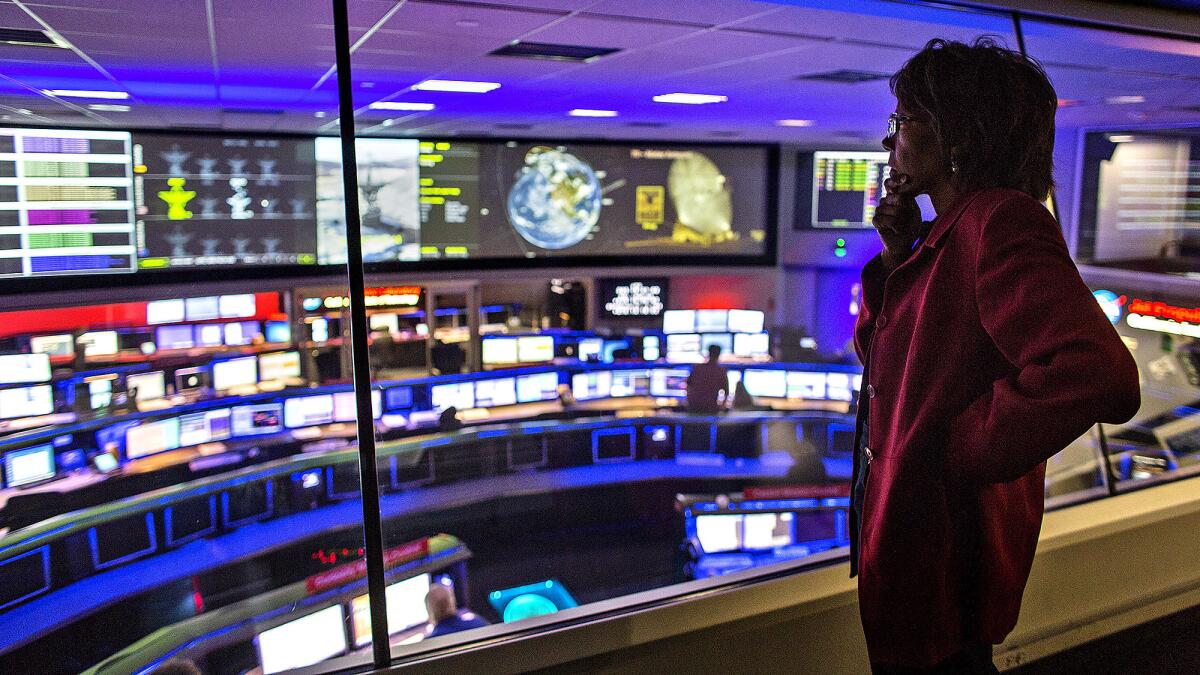Great Read: For Rosetta mission’s scientists, the thrill is in the comet chase

Claudia Alexander, on the view deck of mission control at the Jet Propulsion Laboratory, was the project scientist overseeing NASA’s support role in the European Space Agency’s Rosetta mission.
- Share via
Claudia Alexander has spent the last 15 years of her life waiting for this moment: landing a spacecraft the size of a washing machine on the surface of a speeding comet.
She knows it won’t be easy. The comet is hurtling through space at 84,000 mph, and its icy surface appears to be strewn with large boulders and steep slopes. She doesn’t know whether the comet’s nucleus has the consistency of talcum powder or whether parts of it are hard as diamond.
On Wednesday, the NASA scientist will be with her counterparts at the European Space Agency’s operations center in Darmstadt, Germany, waiting to hear whether the spacecraft has made it to the comet’s surface, and whether it’s still functioning.
The wait will be agonizing. The gravity of the comet is 60,000 times less than the gravity of Earth, and scientists expect it will take the lander seven hours to free-fall from its mother ship, Rosetta, to the comet. Then there is a delay of 28 minutes for a signal from Rosetta to reach our planet.
“There are so many things that could go wrong,” Alexander said recently from her office at NASA’s Jet Propulsion Laboratory in La Cañada Flintridge. “At the same time, you don’t want to not try it.”
From the start, the European Space Agency’s Rosetta mission has unfolded like a suspense novel. There have been twists and turns, and no shortage of nail-biting moments.
As project scientist on Rosetta, Alexander, 55, oversees NASA’s contribution to the mission. That includes three instruments on the orbiter, as well as tracking and navigation support from the agency’s Deep Space Network here on Earth.
She also acts as a kind of diplomat between the two agencies. It has, at times, been a tricky position. NASA isn’t used to playing a supporting role on such high-profile missions.
“We do things a certain way,” she said. “And when you look at someone else doing it their way and not our way, there is a tendency to say, ‘Well, that will never work.’”
Rosetta may be the European Space Agency’s boldest mission yet: to tag along with the 67P/Churyumov-Gerasimenko comet as it passes by the sun, observing it from the Rosetta orbiter and the Philae lander.
“I really want people to understand that these things are difficult to do,” Alexander said. “So if it happens, and we are all jumping up and down, it’s because we really have that feeling like — how did this get pulled off?”
::
Space scientists are fascinated by comets because they believe the mysterious bodies were formed in the earliest days of the solar system, and that frozen into their icy nuclei are the same primordial materials that make up the planets.
European Space Agency researchers named the mission Rosetta because they believe that the study of comets can unlock the secrets of our solar system’s past, just as the Rosetta stone allowed us to unlock the secrets of one of humanity’s ancient cultures.
Alexander keeps a picture of the historic Rosetta stone above her computer. (In fact, she has a whole collection of Rosetta stone paraphernalia, including pot holders, mouse pads, and even a picture of herself standing next to the stone at the British Museum.)
She was 40 when she was brought in as project scientist on the Rosetta mission in 2000. She was young to take on the job, but not unqualified — her doctorate was on comet thermophysical nucleus modeling, and she had already worked on NASA’s Galileo mission to Jupiter.
To NASA management, her age was an advantage.
“They wanted someone who could be with the project all the way through,” she said.
She also thinks being a woman and an African American in a field that is predominantly white and male helped her be a good liaison between the agencies.
“I’m used to walking between two different cultures,” she said. “For me, this is among the purposes of my life — to take us from states of ignorance to states of understanding with bold exploration that you can’t do every day.”
::
When the European Space Agency gave the mission the green light in 1993, the plan was to send the orbiter and lander to the relatively small comet Wirtanen, which measures six-tenths of a mile across.
The agency designed and built the Rosetta spaceship and its Philae lander with Wirtanen in mind. But a few months before launch, engineers discovered a problem in one of the rockets that was supposed to usher the orbiter into space. The launch was postponed and a new target was chosen.
On the plus side, comet 67P is four times larger than Wirtanen, which gave researchers more comet to study. But not everyone was convinced it would be possible to put Philae on the new comet, because the lander was designed to touch down on a significantly smaller comet with even less gravity. If the new comet was too dense, the lander might not survive the descent.
The new flight plan also took the orbiter farther from the sun than expected, and that was a problem. The orbiter relies on two massive solar panel wings that span 105 feet tip to tip for power; as the spacecraft flew farther from the sun, the panels would be unable to generate the necessary energy.
The scientists and engineers at the European Space Agency had no choice but to create a flight plan that included a three-year hibernation.
“A lot of us were very nervous about that,” said Paul Weissman of JPL, one of five interdisciplinary scientists on the mission and the only one from the U.S.
Alexander pauses when asked whether she considers herself a risk-taker.
“I’m definitely not someone who enjoys physical risk. I don’t want to leap out of an airplane. I don’t want to go rock climbing, but I have taken on a lot of sociological risk in my life,” she said. “I took on a career that nobody wanted me to do, not my family, not my friends.
“So I took a risk in not following the fold, let’s put it that way.”
::
Rosetta finally launched on its epic space journey in March 2004. Seven years later, the European Space Agency team carefully put it to sleep. On Jan. 20 this year, four alarm clocks on the spacecraft woke it up from its record slumber.
“I was watching for the signal it woke up from home, and it was early in the morning,” Alexander recalled. “There weren’t even birds chirping yet, and I was just in the dark — literally and metaphorically.
“It was about 45 minutes late. We waited while the minutes clicked past, wondering when are we going into failure mode.... And then the signal came through. God, what a relief that was.”
Since early August, Rosetta has been in orbit around the comet, surveying its surface and gathering intelligence on the best landing site for Philae, which has spent the last decade strapped to the orbiter’s side.
Then, another hurdle: None of the landing options was good.
“As we got better-resolution pictures, we went from saying ‘I want to go there!’ to ‘Are there any other choices?’” Alexander said.
They ended up picking what she describes as “the least-worst one” — a site that gets enough sunlight to power Philae’s solar panels, and that appears to have shallower slopes and fewer boulders than other options.
But as landing day nears, Alexander’s anxiety continues to rise.
“I keep looking at the higher-resolution images and I’m like — what were we thinking? Those slopes look terrible!” she said.
Matt Taylor, Alexander’s counterpart in Europe, said his space agency was well aware of the challenges of landing on the comet.
“It was clear from Day One that an attempt to land on a comet would carry significant risk,” he said. “After all, it is the first time it has been done. If it were easy, someone would have done it already.”
Even if Philae doesn’t have a perfect landing, all is not lost.
The lander will be snapping pictures like crazy as soon as it starts its descent, providing the best images yet of a comet’s nucleus. Sensors on the bottom of the lander will report on the texture of the comet’s surface. Another experiment will essentially take a CT scan of the comet’s nucleus.
“Even just that would be a major step forward in comet science,” Alexander said.
But that doesn’t stop her from worrying about the moment when Philae leaves Rosetta’s side.
“Realizing how little control we have over the landing descent, and going wow — we are really about to put this down. Suddenly it is like — out of our hands now.”
Twitter: @DeborahNetburn







